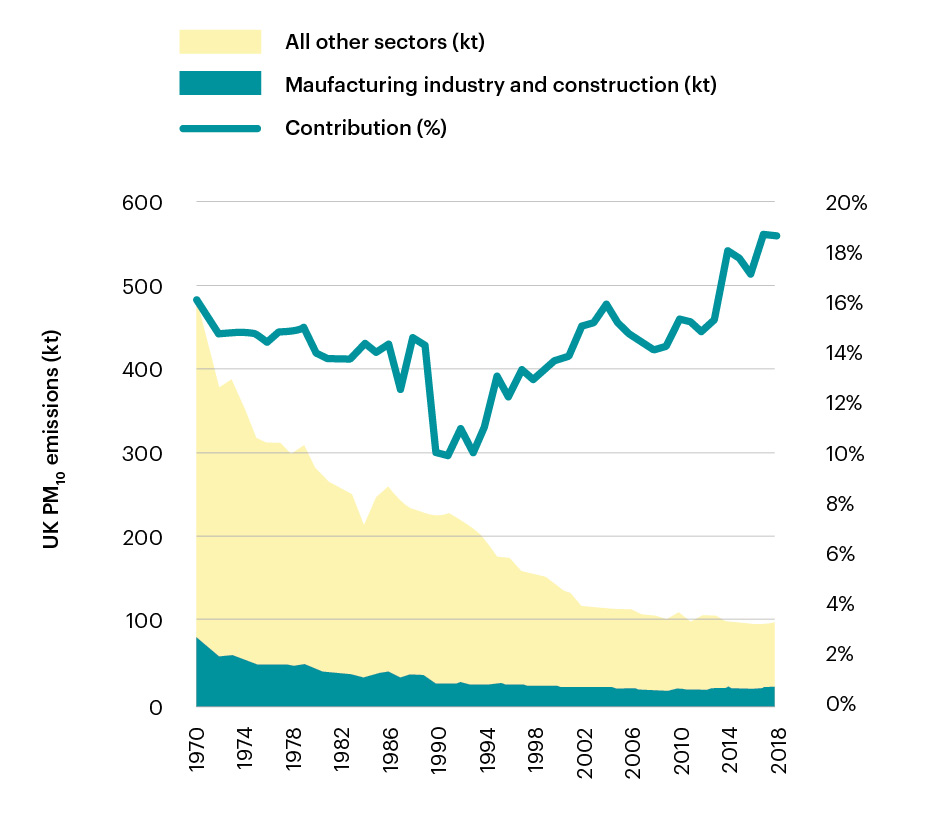New Images Show Photographic Evidence of Air Pollution
Photographs that make invisible air pollution visible have been published, demonstrating the health risks posed to people living and working in Ethiopia, India, and the...
Read Full Article
Data collected from industry stakeholders shows that air pollution from construction sites has been steadily on the rise in recent decades.
The charity, Impact on Urban Health, surveyed industry stakeholders including developers, landowners, and tier-one contractors to examine the links between construction and air pollution.
Whilst city emissions interventions have focussed on the heaviest polluting industry, transport, the construction sector remains a major source of air pollution in cities. In London, for example, construction contributes approximately 30 per cent to particulate matter (PM10), which is a type of pollutant made up of particles smaller than 10 micrometres in size.
A graph from the report shows the increasing contribution of the construction industry to the total amount of Particulate Matter 10 (PM10). As of 2018, the construction industry contributed approximately 19 per cent of all PM10 emissions in the UK:

Picture: a graph that shows the increasing contribution from the construction industry to the total amount of PM10 to UK emissions from 1994-2018. Image Credit: Impact on Urban Health
97 per cent of people surveyed said that air quality is an “extremely or very important environmental health concern”.
Particulate Matter, or PM, affects people more than any other pollutant according to the World Health Organisation, and health impacts even at very low concentrations.
Because of the small size of PM10’s particles, they can penetrate and lodge deep inside the lungs, contributing to the risk of developing cardiovascular and respiratory diseases, as well as lung cancer.
Employees working on construction sites, as well as people living nearby, are most at risk from being exposed to the highest concentrations of emissions from sites.
Ultimately, the report calls for regulatory changes to ensure effective action can be taken to reduce the sector’s air pollution emissions. Respondents commented that local government lacks both the evidence to monitor whether existing regulations are being met and the resources to intervene when they are not. Therefore, more effective compliance is needed, such as more site visits from local authority officers, and even the creation of a Construction Compliance Officer as an air quality champion.
Steve McGregor, who runs the property maintenance business DMA Group, agreed that regulatory change is needed: “If you’re living next door to a large construction site in London with a young family or with respiratory challenges, enforcing improvement is crucial. However, regulatory enforcement of this nature needs a level playing field for organisations of all sizes across the industry.
“This needs reasonable timeframes and specific advice to help enforce change across the industry. We are sitting on the edge of a recession. The construction sector will inevitably slow. Jobs and livelihoods could be at stake in addition to rampant inflationary pressures. We need measured responses to this in order to solve the long-term issue.”
Picture: a photograph of a construction site from above, showing heavy machinery and buildings that are partly under construction. Image Credit: Unsplash
Article written by Ella Tansley | Published 24 October 2022
Photographs that make invisible air pollution visible have been published, demonstrating the health risks posed to people living and working in Ethiopia, India, and the...
Read Full ArticleA trial at the HS2 construction site at Curzon Street has demonstrated that low-cost sensors could determine sources of air pollution. The study, published in npj...
Read Full ArticleThe Building Engineering Services Association (BESA) says it is surprised that changes to pollution laws announced by the government ignore the importance of indoor air...
Read Full ArticleClean Air Day is the UK's largest air pollution campaign, bringing together communities, businesses, schools and the health sector. Watch the...
Read Full ArticleA woman in Canada has recently been the first to be diagnosed with health complications as a direct result of climate-change-induced weather experience. Dr Kyle Merrit...
Read Full ArticleLast month was National Clean Air Month in the US. Why is air quality important? The pandemic has brought consideration of clean air to the public eye, but the quality...
Read Full ArticleOpenAQ, a global nonprofit NGO aiming to build the world’s largest repository of air quality data, have announced a new pilot platform integrating low-cost...
Read Full Article3 million working days a year are lost to air pollution under current targets, according to a report commissioned by the Clean Air Fund. The new study,...
Read Full Article20 nurseries in some of London’s most polluted areas are to receive new indoor and outdoor air quality audits to identify measures to reduce children’s...
Read Full ArticleDespite slow improvements, air pollution continues to exceed European Union and World Health Organization limits and guidelines, according to updated data and information...
Read Full Article